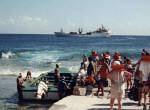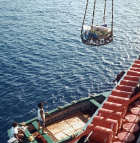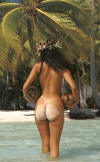Here are answers to a few other questions often asked about the Aranui, a typical cruise is made up of about half Americans and half Europeans. There is an ice machine and water fountain in the reception area. A running tab can be kept in both the boutique and the bar and paid the last day of the cruise.
The Aranui accepts Pacific French Francs, travelers checks, U.S. dollars, and major credit cards for payment. Purchases in the Marquesas Islands are with Pacific French Francs. The shore excursions include the availability of a couple banks and post offices. The cabins come equipped with tissues, coconut soap, and a little shampoo. The cruise goes from dinner meal the night of the boarding to after breakfast the day of disembarkation. Tipping is not customary in any of French Polynesia, including aboard ship.
There were only 2½ days completely at sea. All the other days included visiting two islands in the Tuamotus, and multiple ports at six inhabited Marquesas Islands are visited by the Aranui. Most days we were ashore from 9am-4pm.

The Aranui has to anchor out in nearly all harbors, and both cargo and passengers must go ashore by a wooden motorized whaleboat, which carries up to 40 people. The island ‘docks’ were often 3-4 cement steps up to the landing. After going down the ship’s steps, one must step into a bobbing whaleboat. Fortunately the ocean was calm for most of our voyage, but whatever the water conditions, sailors very carefully supported the arms of each person as they stepped in and out of the whaleboat. In some cases the sailors would even lift a person and carry them over a gap. These men are incredibly strong, and everyone felt very secure. These whaleboat adventures were one of my favorite parts of the voyage.
The thing that impressed me most about the Marquesas is their naturalness – no ‘tourist-attraction-next-5O-yards’ billboards or dime store souvenirs. With only about 7000 people total on the islands, there is a lot of wilderness to be seen.
Lush greenness, coconut trees galore. Rocky cliffs, brightly colored tropical flowers. And silence except for the waves, wind, and birds. We also saw glorious sunsets, rainbows as well as the Southern Cross and other Southern sky constellations. A few postcards and t-shirts can be found here and there, but crafts are the main items for sale: wood carvings, tikis and shell jewelry. Tapa cloth paintings, and tie dyed pareos to wear. Black pearls are available in Takapoto ranging from $60-$200. Traveler’s checks are accepted for the purchase of pearls.
To get the most from the shore excursions, be prepared to walk. I was able to not gain any weight, eating as much as I wanted, by all the walking I did. Often walking is the only way to get to an ancient Maraes – Tahitian religious site with stone tikis – as roads are limited in this part of the world. Many roads that do exist are bumpy with rocks and rutted by rain, and a 4-wheel drive was the only way to ride over them. We did that on a couple of occasions and had a breathtaking panoramic view from the island’s highest point.
Sometimes there are various shore activities to choose from, such as a hike, a visit to the village, or swimming and snorkeling. Horseback riding, on wooden saddles, was also offered twice for an additional fee.

![]()
An interesting alternative to walking is to watch the crew unload and load cargo. The cranes swing large quantities of cargo into a whaleboat. Everything from potato chips and beer to a car to a live horse was unloaded during our voyage. The Aranui foreman checked off the items on his clipboard and then prepared to reload the islands’ exports, which are chiefly copra (dried coconut) and limes. The Aranui pays cash for a 60 lb. bag of dried coconut. They sell it on the mainland and coconut oil is made.
There are often children playing in the water, and their innocent fun is joy to watch too. In the evening some of the sailors would often play their ukuleles and guitars and sing happy, lilting Tahitian Marquesa tunes up by the bar area. Sometimes couples got up and danced. Saturday nights were especially the party nights as the Aranui ‘s sailors didn’t have to work on Sundays except to ferry passengers ashore.

The minor discomforts of humidity, and sun were a small price to pay for the magnificent scenery of remote tropical islands that few Americans ever have a chance to visit. I loved the flower leis, the landscapes suitable for framing and the happy, friendly people with their cheerful music; I’m ready to go back again someday.
The Society Islands
To end our stay in the South pacific we spent four days on Bora Bora and a week on Cook’s Bay on the island of Moorea. Both were lovely, but the tourists are overtaking these island as the cruise lines now have three ships “working the area” and tourists and buses are all over the place. It will be only a short time before all the charm will be lost.
A larger ship to replace the Aranui is being built, and will be ready in a couple of years. It will be larger and take more passengers. I urge you, if interested, to take this trip before this happens as it will never be the same.